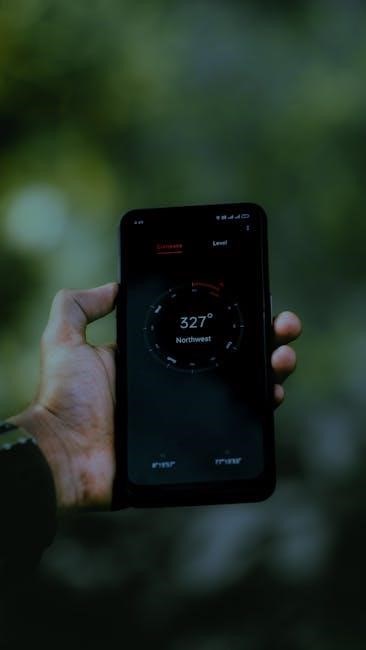nikon d500 user guide
- Published
- in Guide
The Nikon D500 is a powerful DSLR camera designed for enthusiasts and professionals, offering advanced features like 4K video, fast autofocus, and robust weather sealing․ This guide provides comprehensive insights into its operation, customization, and troubleshooting, ensuring you maximize its potential for stunning photography and videography․
Overview of the Nikon D500
The Nikon D500 is a high-performance DSLR camera designed for photography enthusiasts and professionals․ It features a 20․9MP APS-C sensor, EXPEED 5 image processor, and robust weather-sealing․ With a wide ISO range (100-51200) and 10 fps burst mode, it excels in capturing dynamic action and low-light scenes․ The camera also supports 4K video recording and offers advanced autofocus with 153 phase-detection points․ Its compatibility with Nikon’s ecosystem of lenses and accessories makes it a versatile tool for creative expression and customization․
Key Features and Specifications
The Nikon D500 boasts a 20․9MP DX-format CMOS sensor and EXPEED 5 processor, delivering exceptional image quality and fast performance․ It offers 4K UHD video recording at 30p, 1080p at 60p, and built-in SnapBridge for wireless connectivity․ The camera features a 3․2-inch tilting touchscreen LCD, 100-51200 ISO range, and 10 fps continuous shooting․ Its advanced 153-point AF system with 99 cross-type sensors ensures precise subject tracking․ Weather-sealing and dual card slots enhance durability and versatility for professional-grade photography․

Setting Up Your Nikon D500
Unbox and initialize your Nikon D500 by charging the battery, mounting lenses, and configuring basic settings for optimal performance and personalized photography experience․
Unboxing and Initial Setup
Unboxing your Nikon D500 is an exciting first step․ Carefully inspect the contents, including the camera body, EN-EL15 battery, charger, and accessories․ Insert the battery into the grip, ensuring it clicks securely․ Plug in the charger and allow the battery to fully charge before use․ Upon first power-on, navigate through the initial setup menu to select language, time zone, and date format․ This process ensures your camera is ready for immediate use and personalized to your preferences․
Charging and Battery Management
The Nikon D500 uses the EN-EL15 battery, which requires approximately 2 hours and 30 minutes to fully charge using the supplied MH-25 charger․ Always use genuine Nikon chargers to ensure safety and optimal performance․ Avoid overcharging, as it can reduce battery lifespan․ Check battery level via the camera’s menu or the CHARGE lamp on the charger․ For extended use, consider purchasing a spare battery․ Nikon also offers a battery replacement program for certain models․ Proper management ensures reliable power during shoots and extends battery longevity․
Mounting Lenses and Accessories
The Nikon D500 is compatible with Nikon F-mount lenses, offering a wide range of creative possibilities․ To mount a lens, align the lens mount index with the camera’s white mark, then rotate clockwise until it clicks․ For accessories like the MB-D17 battery grip, ensure compatibility and secure attachment․ Always handle lenses with care to avoid damage․ Regularly clean the lens and camera mounts to prevent dust and ensure proper connections․ Using genuine Nikon accessories guarantees optimal performance and compatibility with your D500․

Navigating the Camera Modes
The Nikon D500 offers a variety of modes, including Auto, P, S, A, and M, as well as scene modes like Portrait and Landscape․ Use the mode dial to select the desired mode, with options for full manual control or automated settings to suit your photography style and experience level․
Understanding the Mode Dial
The Nikon D500’s mode dial provides quick access to various shooting modes․ Auto Mode offers point-and-shoot simplicity, while P (Programmed Auto) allows for basic adjustments․ Manual (M), Aperture Priority (A/Av), and Shutter Priority (S/Tv) modes grant full control for advanced users․ Scene modes like Portrait, Landscape, and Close-Up optimize settings for specific subjects․ Rotate the dial to select the mode that matches your creative goals, ensuring optimal results in different photography scenarios․ This intuitive system helps you adapt to changing conditions efficiently․
Manual, Aperture Priority, and Shutter Priority Modes
Manual (M) mode offers complete control over aperture and shutter speed, ideal for creative experimentation․ Aperture Priority (A/Av) allows you to set the aperture while the camera adjusts the shutter speed for proper exposure․ Shutter Priority (S/Tv) lets you control the shutter speed, with the camera adjusting the aperture․ These modes empower photographers to achieve specific effects, such as depth of field or motion blur․ Use the mode dial to select M, A/Av, or S/Tv, then adjust settings using the command dials for precise control over your shots․
Auto and Scene Modes
Auto Mode simplifies photography by automatically adjusting settings for optimal results, ideal for beginners or quick shots․ Scene Modes tailor settings for specific scenarios like Portrait, Landscape, Sports, and Close-Up, enhancing image quality in various conditions․ These modes allow photographers of all skill levels to capture stunning images effortlessly, with the camera handling complex adjustments internally․ Use the mode dial to select Auto or a Scene Mode, and let the Nikon D500 deliver professional-grade results with minimal effort required․

Customizing Your Shooting Experience
Personalize your Nikon D500 to suit your preferences and shooting style․ Configure autofocus settings, metering modes, and white balance for precise control over your photography experience․
Configuring Autofocus Settings
The Nikon D500 features an advanced autofocus system with various customization options․ You can choose between Single AF for stationary subjects and Continuous AF for moving subjects․ The camera also offers Auto Area AF, which automatically selects focus points based on the scene․ Users can customize AF modes, such as adjusting the AF-C modes for different shooting scenarios, and even fine-tune the autofocus for specific lenses․ These settings can be accessed through the camera menu or via custom controls, allowing for a personalized shooting experience tailored to your needs;
Adjusting Metering Modes
The Nikon D500 offers multiple metering modes to ensure accurate exposure․ Matrix Metering analyzes the entire scene for balanced results, while Center-Weighted Metering prioritizes the center of the frame․ Spot Metering measures a specific area, ideal for high-contrast situations․ You can select these modes via the camera menu or a dedicated button․ Each mode adapts to different lighting conditions, allowing you to achieve the desired exposure․ Experimenting with these settings helps refine your photography, ensuring optimal results in various shooting environments․
White Balance and ISO Settings
The Nikon D500 allows precise control over white balance to match lighting conditions, ensuring accurate colors․ Options include Auto, Daylight, Cloudy, and custom settings using a gray card․ For ISO, the camera offers a range of 100 to 51,200, enabling flexibility in low-light situations․ Lower ISOs minimize noise, while higher settings are ideal for dim environments․ Adjusting these settings via the camera menu or dedicated buttons ensures optimal image quality․ Proper use of white balance and ISO enhances color accuracy and reduces noise, delivering professional-grade results in various shooting scenarios․

The Viewfinder and LCD
The Nikon D500 features a high-resolution optical viewfinder and a 3․2-inch tilting LCD screen․ The viewfinder offers 100% frame coverage for precise composition, while the LCD provides touch functionality and vibrant image previews, enhancing shooting and playback experiences․
Understanding the Optical Viewfinder
The Nikon D500’s optical viewfinder provides a clear, lag-free view of your scene with 100% frame coverage․ It offers 1․0x magnification and a 16mm eyepoint, making it comfortable for glasses wearers․ The viewfinder displays essential shooting data, including aperture, shutter speed, and ISO․ A diopter adjustment ensures sharp focus for your eyes․ Customizable grid lines and electronic virtual horizon aid composition․ The viewfinder’s brightness adjusts naturally, providing an accurate preview of your shot․ This feature-rich design enhances your shooting experience, helping you capture moments with precision and confidence․
Navigating the Rear LCD Screen
The Nikon D500 features a 3․2-inch, 2,359,000-dot tilting touchscreen LCD, offering exceptional clarity and flexibility․ The touchscreen allows intuitive menu navigation and autofocus point selection․ Use the Shooting Info Display to review camera settings at a glance․ The LCD supports Live View for composing shots and reviewing images․ Its tilting design is ideal for shooting from unique angles․ The high-resolution display ensures vibrant image playback and precise preview of adjustments․ This versatile tool enhances your shooting experience, providing quick access to essential controls and settings․
Using Live View Mode
Live View Mode on the Nikon D500 allows for precise composition and focus control using the rear LCD screen․ Activate it via the LV button, enabling real-time preview of your scene․ The 3․2-inch tilting touchscreen is ideal for shooting at unique angles or in awkward positions․ Utilize touch AF to quickly select focus points or switch to manual focus with focus peaking for precise control․ Live View also supports video recording and provides a preview of settings like exposure and white balance․ This feature enhances creative control and ensures sharp, well-composed images in any situation․

Advanced Shooting Techniques
Explore advanced techniques like focus peaking, time-lapse photography, and silent shooting to enhance your creative control and capture stunning images with precision and versatility․
Burst Mode and Continuous Shooting
The Nikon D500 excels in capturing fast-paced action with its burst mode, delivering up to 10 frames per second in continuous high-speed shooting․ This feature is ideal for wildlife, sports, and dynamic scenes․ The camera’s buffer allows for an impressive 200 shots in RAW format, ensuring uninterrupted shooting sessions․ Access burst mode via the camera’s Mode Dial or customize controls for quick activation․ Use this feature to freeze fleeting moments and capture sharp, sequential images with precision and ease, making it a powerful tool for professional photographers and enthusiasts alike․
Bracketing and HDR Photography
The Nikon D500 supports advanced bracketing and HDR photography, ideal for capturing high-contrast scenes․ Bracketing allows you to shoot up to 9 frames at varying exposures, which can later be merged using Nikon’s HDR software․ Enable bracketing via the Shooting Menu, and customize the number of shots and exposure intervals․ For HDR, the camera can automatically combine images in-camera or save individual frames for post-processing․ This feature is perfect for landscapes, interiors, and scenes with extreme lighting conditions, ensuring detailed shadows and highlights in your final images․
Focus Stacking and Focus Peaking
Focus stacking on the Nikon D500 enhances depth of field by combining multiple images with varying focus points․ Use the Focus Shift Shooting feature in the Shooting Menu to capture up to 300 shots, which can be stacked using Nikon software․ Focus Peaking, available in Live View, highlights in-focus areas with a selectable color, aiding manual focus precision․ These techniques are ideal for macro, landscape, and product photography, ensuring sharpness across your frame while maintaining creative control over focus placement and depth․

Video Recording with the Nikon D500
The Nikon D500 excels in video recording, offering 4K UHD capture at 30p and Full HD at 60p․ It supports flat profiles for color grading and external microphone inputs for enhanced audio quality, making it a versatile tool for professional and creative videography․
Setting Up for Video Capture
To begin video recording on the Nikon D500, switch to Live View mode and select Movie Settings in the menu․ Choose your preferred frame rate and resolution, such as 4K UHD at 30p or Full HD at 60p․ Stabilize the camera using a tripod for smooth footage․ Enable external microphone input for high-quality audio․ Adjust white balance and autofocus settings to match your scene․ Refer to pages 123-125 of the user manual for detailed setup instructions and optimal configuration tips․
4K Video and Frame Rates
The Nikon D500 excels in video recording, offering stunning 4K UHD resolution at 30p and Full HD at 60p․ For cinematic results, select 24p in Full HD․ Ensure your memory cards meet the necessary speed requirements to handle 4K data rates․ Use the camera’s built-in stabilization and external microphones for smoother footage and clearer audio․ Refer to the user manual for frame rate customization and optimal video settings to capture professional-grade content with ease and precision․
Audio Recording and External Microphones
Enhance your video quality with the Nikon D500’s advanced audio capabilities․ The camera supports external microphones via a 3․5mm stereo jack, reducing wind noise and capturing clearer dialogue․ Use the built-in audio level controls to adjust sensitivity and ensure balanced sound․ For professional-grade audio, pair the D500 with external microphones like the Nikon ME-1 or third-party options․ This setup ensures high-quality sound to complement your 4K video, making it ideal for vloggers and filmmakers seeking polished results․

Post-Processing and Sharing
Master post-processing and sharing with the Nikon D500․ Use Nikon NX Studio for editing and SnapBridge for seamless image transfer to your smart devices․
Transferring Images to a Computer
Transferring images from your Nikon D500 to a computer is straightforward․ Use the built-in Wi-Fi and Bluetooth connectivity to wirelessly transfer photos via the SnapBridge app․ For a wired connection, connect the camera to your computer using a USB cable․ Install Nikon’s software to transfer and organize your files efficiently․ Customize transfer settings to suit your workflow for seamless image management․
Editing Photos with Nikon Software
Nikon offers powerful software for editing photos, including ViewNX-i and Capture NX-D․ ViewNX-i allows you to organize, edit, and enhance your images with tools like exposure adjustment and color correction․ Capture NX-D provides advanced RAW image processing, enabling precise control over details, noise reduction, and white balance․ Both programs are free to download, offering professional-grade editing capabilities tailored for Nikon cameras like the D500․ These tools help you unlock the full potential of your photos with ease and precision․
Sharing Images via SnapBridge
SnapBridge is Nikon’s app for seamless image sharing between your D500 and smart devices․ Download and install the app, then connect your camera via Bluetooth or Wi-Fi․ Automatic transfers allow photos to be sent to your device as you shoot․ Easily share images on social media, cloud storage, or messaging platforms․ SnapBridge also enables remote camera control, enhancing your workflow․ This feature-rich tool streamlines sharing and backs up your images, making it indispensable for photographers on the go․

Troubleshooting Common Issues
Address common issues like battery drain or autofocus malfunctions by checking the user manual or Nikon’s support page for detailed solutions and firmware updates․
Resolving Battery and Charging Problems
If you encounter battery drain or charging issues with your Nikon D500, check the EN-EL15 battery type, as two variants exist․ Ensure proper charging using the supplied charger․ Clean the battery terminals and reset the camera if needed․ Update firmware for compatibility and contact Nikon support if issues persist․
- Verify battery type (EN-EL15a or EN-EL15b) for compatibility․
- Clean terminals with a soft cloth to improve connectivity․
- Use genuine Nikon chargers to avoid charging malfunctions․
- Reset camera settings to factory defaults if issues arise․
- Check for firmware updates to ensure optimal battery performance․
- Contact Nikon support for battery replacement if problems persist․
Fixing Autofocus and Metering Issues
To resolve autofocus and metering problems on your Nikon D500, start by cleaning the AF sensor and F-mount contacts with a soft cloth․ Reset the camera to factory settings and ensure the firmware is up to date․ Check metering modes and adjust settings for accurate exposure․ Verify lens compatibility and clean the lens contacts․ Use the appropriate AF-area mode for your subject and recalibrate if necessary․ These steps will help restore optimal autofocus and metering performance․
- Clean the AF sensor and lens contacts regularly․
- Update camera firmware for improved functionality․
- Adjust metering modes based on lighting conditions․
- Use the correct AF-area mode for precise focus․
- Calibrate lenses if focus accuracy issues persist․
Updating Firmware and Software
Regular firmware updates enhance the Nikon D500’s performance and fix issues․ Visit Nikon’s official website, download the latest firmware, and follow on-screen instructions․ Use a fully charged battery and avoid interruptions during updates․ Ensure the memory card is formatted and the firmware file is correctly copied․ After updating, restart the camera to apply changes․ Always verify the firmware version in the camera menu to confirm successful installation․ This ensures optimal functionality and compatibility with lenses and accessories․
- Download firmware from Nikon’s support website․
- Use a formatted memory card for the update․
- Avoid power interruptions during installation․
- Restart the camera after updating․
- Check the firmware version post-update․

Mastering the Nikon D500 requires practice and exploration․ This guide provides a solid foundation, but continued learning through Nikon’s resources and hands-on experience will elevate your skills further․
Final Tips for Mastering the Nikon D500
To fully master the Nikon D500, experiment with different shooting modes and settings․ Regularly update firmware for optimal performance․ Utilize Nikon’s official resources and user manuals for in-depth guidance․ Practice techniques like focus stacking and HDR photography to enhance your results․ Engage with photography communities and workshops to refine your skills․ By combining hands-on experience with continuous learning, you’ll unlock the D500’s full potential and achieve exceptional photography outcomes․
Resources for Further Learning
For deeper understanding, download the official Nikon D500 user manual and Menu Guide from Nikon’s website․ Explore detailed PDF resources, tutorials, and workshops․ Visit Nikon’s support page for firmware updates and troubleshooting guides․ Join photography forums and communities to share experiences and learn from experts․ Utilize Nikon’s SnapBridge app guide for seamless image sharing․ These resources will help you unlock advanced features and enhance your photography skills with the Nikon D500․
